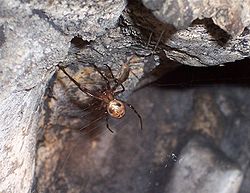- Meta menardi
-
European cave spider 
Scientific classification Kingdom: Animalia Phylum: Arthropoda Class: Arachnida Order: Araneae Family: Tetragnathidae Genus: Meta Species: M. menardi Binomial name Meta menardi
(Latreille, 1804)The European cave spider, Meta menardi, is a long-jawed orb-weaving spider (Family Tetragnathidae)[1] it is also known as the Orbweaving cave spider, the Cave orbweaver and simply the Cave spider (in context).
Contents
Habitat
They have a natural range extending from Scandinavia to North Africa and from Europe to Korea, there are also transplanted populations as far apart as Japan and Madagascar.
The adult spiders are photophobic and live in places free from light, frequently in caves and tunnels, though they can sometimes be seen outside of caves and mines as they will emerge around dusk to hunt, often using a single silk lasso line and swinging down upon their prey to catch, they often have a symbiotic relationship with cave bats and are found in areas that are frequented by bats, they are most often observed in railway tunnels and mines since these are more likely to be visited by humans. The young spiders are, in contrast, strongly attracted to light[2] — probably an evolutionary adaptation which ensures the spread of the species to new areas.
Morphology
They are shiny satin black to reddish brown in colour, often having a different coloured rear body which varies from black,brown or even olive green and are one of the largest spiders found in the United Kingdom with adults reaching roughly 5 cm legspan and 15 mm body length. However, the Cardinal Spider and the raft spider are larger. It is widespread and locally abundant[3], although rarely noticed due to its habits. They are neither endangered nor protected[4] in the UK.
Egg sacs are tear shaped white pendants (sometimes with a slightly yellow centre) usually hanging from the roof of the habitat by a silk thread approximately 20 mm long.
Meta menardi is extremely difficult to distinguish from Meta bourneti, to the extent that differentiation requires a microscope and considerable expertise. Meta bourneti has similar range and habits to Meta menardi and non arachnologists rarely bother with the distinction referring to both species by the same common name.
Cave spiders feed on smaller invertebrates, most frequently myriapods and slugs [5].
The European cave spider is not dangerous to humans and although (in common with nearly all spiders) they have venom, its effect on large mammals is negligible. They are unlikely to bite if carefully handled but if sufficiently provoked they are capable of inflicting an unpleasant "nip". They are non-aggressive and generally slow moving and are regarded (by arachnophiles) as "gentle giants".
Media mistakes
A media frenzy was caused[says who?] when British Telecom engineers working in the grounds of Windsor Castle discovered a colony living in conduits and manholes. These were incorrectly described[by whom?] as swarms of aggressive spiders, up to 10 cm in size. The error was compounded when they were identified as a new and probably highly venomous species by Graham Smith, a misinformed entomologist.[6] The initial incident was widely reported but when the species was properly identified the matter received little publicity.
References
- ^ Locket, Millidge & Merrett, British Spiders vol III, 1974, ISBN 978-0903874021
- ^ Smithers P, Bulletin of the British Arachnological Society, 2005, Vol 13; Part 6 Pages 213-216
- ^ National Biodiversity Network, http://www.searchnbn.net/gridMap/gridMap.jsp?allDs=1&srchSpKey=NBNSYS0000008929
- ^ UK Joint Nature Conservation Committee, http://www.jncc.gov.uk/page-1815
- ^ Peter Smithers, Journal of Arachnology, August 2005
- ^ BBC News, http://news.bbc.co.uk/2/hi/uk_news/1396706.stm, 19 June 2001
Further reading
- Smithers, Peter (2005). "The diet of the cave spider Meta Menardi". Journal of Arachnology 33: 243–246. http://www.americanarachnology.org/JoA_free/JoA_v33_n2/arac-033-02-0243.pdf. Retrieved 2010-11-18.
External links
- Pictures of Meta menardi at Nick's Spiders
Categories:- Tetragnathidae
- Spiders of Europe
- Cave spiders
- Animals described in 1804
Wikimedia Foundation. 2010.
